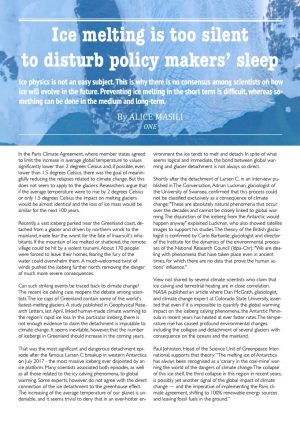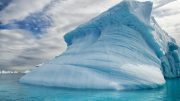 In the Paris Climate Agreement, where member states agreed to limit the increase in average global temperature to values significantly lower than 2 degrees Celsius and, if possible, even lower than 1.5 degrees Celsius, there was the goal of meaningfully reducing the relapses related to climate change. But this does not seem to apply to the glaciers. Researchers argue that if the average temperature were to rise by 2 degrees Celsius or only 1.5 degrees Celsius the impact on melting glaciers would be almost identical and the loss of ice mass would be similar for the next 100 years.
In the Paris Climate Agreement, where member states agreed to limit the increase in average global temperature to values significantly lower than 2 degrees Celsius and, if possible, even lower than 1.5 degrees Celsius, there was the goal of meaningfully reducing the relapses related to climate change. But this does not seem to apply to the glaciers. Researchers argue that if the average temperature were to rise by 2 degrees Celsius or only 1.5 degrees Celsius the impact on melting glaciers would be almost identical and the loss of ice mass would be similar for the next 100 years.
Recently, a vast iceberg parked near the Greenland coast, detached from a glacier and driven by northern winds to the mainland, made fear the worst for the fate of Inaarsuit’s inhabitants. If the mountain of ice melted or shattered, the remote village could be hit by a violent tsunami. About 170 people were forced to leave their homes, fearing the fury of the water could overwhelm them. A much-welcomed twist of winds pushed the iceberg further north, removing the danger of much more severe consequences.
Can such striking events be traced back to climate change? The recent ice calving case reopens the debate among scientists. The ice caps of Greenland contain some of the world’s fastest-melting glaciers. A study published in Geophysical Research Letters, last April, linked human-made climate warming to the region’s rapid ice loss. In this particular iceberg, there is not enough evidence to claim the detachment is imputable to climate change. It seems inevitable, however, that the number of icebergs in Greenland should increase in the coming years.
That was the most significant and dangerous detachment episode after the famous Larsen C breakup in western Antarctica on July 2017 – the most massive iceberg ever disjointed by an ice platform. Many scientists associated both episodes, as well as all those related to the icy calving phenomena, to global warming. Some experts, however, do not agree with the direct connection of the ice detachment to the greenhouse effect. The increasing of the average temperature of our planet is undeniable, and it seems trivial to deny that in an ever-hotter environment the ice tends to melt and detach. In spite of what seems logical and immediate, the bond between global warming and glacier detachment is not always so direct.
Shortly after the detachment of Larsen C, in an interview published in The Conversation, Adrian Luckman, glaciologist of the University of Swansea, confirmed that this process could not be classified exclusively as a consequence of climate change: “These are absolutely natural phenomena that occur over the decades and cannot be closely linked to global warming. The disjunction of the iceberg from the Antarctic would happen anyway” explained Luckman, who also showed satellite images to support his studies. The theory of the British glaciologist is confirmed by Carlo Barbante, glaciologist and director of the Institute for the dynamics of the environmental processes of the National Research Council (Idpa-Cnr): “We are dealing with phenomena that have taken place even in ancient times, for which there are no data that prove the human actions’ influence.”
View not shared by several climate scientists who claim that ice calving and terrestrial heating are in close correlation. NASA published an article where Dan McGrath, glaciologist, and climate change expert at Colorado State University, asserted that even if it is impossible to quantify the global warming impact on the iceberg calving phenomena, the Antarctic Peninsula in recent years has heated at ever faster rates. The temperature rise has caused profound environmental changes, including the collapse and detachment of several glaciers with consequence on the oceans and the mainland.
Paul Johnston, Head of the Science Unit of Greenpeace International, supports that theory: “The melting ice of Antarctica has always been recognised as a ‘canary in the coal-mine’ warning the world of the dangers of climate change. The collapse of this ice-shelf, the third collapse in this region in recent years, is possibly yet another signal of the global impact of climate change — and the imperative of implementing the Paris climate agreement, shifting to 100% renewable energy sources and leaving fossil fuels in the ground.”
Johnson urges governments to act: “No one knows for sure if climate change played a definitive role in the break of the Larsen C ice shelf, but given the relatively recent breakup of other shelves, and the contribution thought to have been made to erosion of the ice by warmer waters around the Antarctic Peninsula in those cases, it seems likely that human activities are a factor. We are still in the safe zone to avoid catastrophic climate change. But we must act fast. Decisions taken now by governments and industry will decide whether billions of people have safe, prosperous lives in the future”.
The changes are even more evident in the Arctic Circle – the dramatic reduction of sea ice, the Greenland ice cap melting, the glaciers retreat and the permafrost thawing. In 2018, Greenland has already recorded 61 hours above zero, three times more than in any previous year. Its ice is melting rapidly, but part of the water produced by the process does not end up in the sea and remains on the island. Water remains trapped in the thickest ice, which has a low density and high porosity, characteristics that allow it to retain it. The dissolved water is vertically channeled into structures called “moulins”, and instead of ending up in the sea remains imprisoned in the porous ice, where it can refreeze. The phenomenon was thought to be of little significance, but further analysis revealed that the original estimates on water dispersed at sea could be wrong by a massive 21-58% margin. According to Michael Mann, a climate scholar at Pennsylvania State University, Arctic ice is disappearing 50 years earlier than expected by scientists.
According to NASA glaciers in the world would decrease by 13.2% every ten years. The question mark is what happens afterwards. The ice, being white, like a shield, reflects most of the solar radiation towards the sky, therefore also the heat. Because of the rise in temperature ice melts and increase the darker surface, which absorbs more heat, helping to raise further the temperature that melts the ice even more. A vicious circle that is difficult to escape without rapid and effective intervention on greenhouse gas emissions. The Sleeping giant is how climatologists call the permafrost, the layer of icy terrain typical of Siberia, composed of vegetable biomass, remains of ancient forests. It contains enormous quantities of greenhouse gases such as methane and carbon dioxide. Frozen, as in a time capsule, it is now opening due to the temperature rise. A study conducted by the CNR and the University of Stockholm, published in Nature Communication, estimates that at the end of 2100, the release of greenhouse gases by permafrost could reach a quarter of all emissions related to the use of fossil fuels. The ice physics is not an easy subject. This is why there is no consensus among scientists on how ice will evolve in the future. For sure preventing ice melting in the short term is very difficult, whereas something can be done in the medium and long-term.
A new study of researchers at the Bremen (Germany) and Innsbruck (Austria) universities concludes that even if our greenhouse gas emissions fall to zero the melting of the Earth’s vast glaciers will not stop in this century. It is mainly due to the inertia of the phenomena and the slow reaction of the glaciers to climate changes, which only in recent years have begun to heavily suffer from the increase in the temperature of the last decades. Nevertheless, one day you have to start doing something if you want to stop the trend. If the governments keep their promises to counter global warming, the pattern could change. Despite diverging views, experts agree that it is necessary to act quickly, as indicated in the Paris Climate Agreement, and drastically reduce CO2 and other greenhouse gases released into the atmosphere. So why not pursue a less polluting energy and transport policy and have a sustainable impact on the environment? The transition from fossil fuels towards renewable and clean energy sources is taking ages, but it could be much faster. If only policymakers would adopt more ambitious and braver measures on a global scale, like supporting and implementing the rational and efficient use of energy and materials, catastrophic scenarios could be avoided. Unfortunately we are doing too little and too slowly, whereas the climate changes rapidly.
Alice Masili





